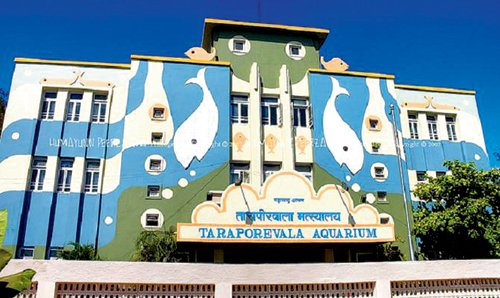Your Hand Could Be Killing The Fish At Taraporevala
The Damsels are in distress. So are the Angels and the Tangs. All told, some 2,100 fish have died in the nine months that Taraporevala Aquarium remained open – from March 3 to December 31, 2015 – after its renovation.
In response to an RTI query from this newspaper, the fisheries department — which maintains the aquarium — listed four main reasons for the high mortality rate: polluted sea water, constant tapping on tanks by visitors, use of flash which stuns the fish and environmental factors. The RTI response says 2095 fish from 228 species (130 from marine, 37 from freshwater and 61 from tropical category) had died in less than nine months. At present, the aquarium has about 1,200 fish of different species, turtles and tortoises, frogs and lizards. Chief Minister Devendra Fadnavis described the situation as “quite serious”.
The aquarium was set up in 1951 and is India’s oldest aquarium. It was constructed at a cost of Rs 8 lakh and named after Parsi philanthropist DB Taraporevala who had donated Rs 2 lakh for setting it up. After the state government failed in its many attempts to set up oceanariums or aquariums of larger size, it decided to refurbish the Taraporevala Aquarium. In March 2015, the aquarium was thrown open to the public after the government spent Rs 22 crore on its renovation.
The state fisheries department, however, does not have the expertise to run a large aquarium like Taraporevala and appointed a Borivali-based firm — Utekar Fisheries – for supplying the fish as well as the feed.
Rupesh Utekar, director of Utekar fisheries told Mumbai Mirror: “We secured a contract of supplying fish worth Rs 1.06 crore and feed for Rs 49.8. We import a lot of fish and the feed.” Utekar said that he was fined Rs 3 lakh initially when a lot of fish had died. He could not give details on mortality rate and how many had been supplied to the aquarium so far. “We normally quarantine the fish for five days, but the fisheries department felt that the quarantine period was less and we were fined when the fish died in large numbers.”
Utekar said that a large number of fish died when the aquarium opened last year. “Before the aquarium opened, there was darkness and surroundings were quiet. On the first day, there were 15,000 visitors due to which the fish were traumatised. Besides, people used flash to take pictures.”
Astaffer at the aquarium said that Mondays are the worst days for the fish as footfalls are very high over the weekends. “We have come across several incidents when the fish do not come out for feeding after weekends,” he said. Curator Ajinkya Patil said, “The fish face stress when visitors tap on the tanks. We have deployed security personnel but the visitors don’t listen.”
Aquarium staffers say that banning photography is one way of curbing the deaths. Currently, photography is permitted after payment of a fee: Rs 500 for cell phones and Rs 1,000 for conventional cameras.
Another reason for the high mortality rate is the polluted sea water that is sourced for the aquariums. While the fisheries department maintains that exact sea-like conditions cannot be replicated in the fish tanks, staffers at the aquarium said that a line must be laid in the sea to tap water six to 10 km away, so that fish get good quality sea water.
The RTI reply by the fisheries department provides details of the fish that have died. It states that among the dead fish, 104 are from the Damsel category. The sub-categories are three striped Damsel, four striped damsel, jewel damsel, domino damsel, lemon damsel, azure damsel, blue damsel, blue velvet damsel, blue line damsel, cloudy damsel, Fiji blue devil damsel, talbots damsel, starks damsel and sergeant major damsel. The reply says 63 fish from the Butterfly category, 25 eels, 53 fish from Tang species, 43 frogs and 41 lizards have also died. There are a large number of casualties from the tropical varieties too.
Published on Mumbai Mirror





